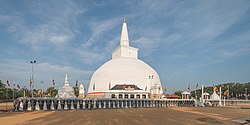Anuradhapura
අනුරාධපුර அனுராதபுரம் | |
|---|---|
 | |
| Coordinates: 8°20′6″N 80°24′39″E / 8.33500°N 80.41083°E | |
| Country | Sri Lanka |
| Province | North Central Province |
| District | Anuradhapura |
| Established | 5th century BC |
| Government | |
| • Type | Municipal Council |
| Area | |
• City | 7,179 km2 (2,772 sq mi) |
| • Urban | 36 km2 (14 sq mi) |
| Elevation | 81 m (266 ft) |
| Population (2012) | |
• City | 50,595 |
| • Density | 2,314/km2 (5,990/sq mi) |
| Demonym | Anuradhians |
| Time zone | UTC+5:30 (Sri Lanka Standard Time Zone) |
| Postal code | 50000 |
| Official name | Sacred City of Anuradhapura |
| Criteria | Cultural: ii, iii, vi |
| Reference | 200 |
| Inscription | 1982 (6th Session) |
Anuradhapura (Sinhala: අනුරාධපුරය, romanized: Anurādhapuraya; Tamil: அனுராதபுரம், romanized: Aṉurātapuram) is a major city located in the north central plain of Sri Lanka. It is the capital city of North Central Province and the capital of Anuradhapura District. The city lies 205 kilometers (127 mi) north of the current capital of Colombo in the North Central Province, on the banks of the historic Malwathu Oya. The city is now a World Heritage Site famous for its well-preserved ruins of the ancient Sinhalese civilisation.
While Mahāvaṃsa places the founding of the city in 437 BCE, the site has been inhabited for much longer, making it a major human settlement on the island for almost three millennia and one of the oldest continuously occupied cities in Asia. It is the cradle of the Hydraulic Sinhalese civilisation, Theravada Buddhism, and the longest-serving ancient capital of Sri Lanka that has survived for 1500 years. Moreover, It was the first capital of the Sinhala Kingdom of Rajarata, following the kingdoms of Tambapanni and Upatissa Nuwara. Anuradhapura was also the centre of Theravada Buddhism for many centuries and has been a major Buddhist pilgrimage site with ruins of many ancient Buddhist temples, including the famous Anuradhapura Maha Viharaya and the Jaya Sri Maha Bodhi, the oldest still-living, documented, planted tree in the world[1] and that is believed to have originally been a branch of the sacred fig tree at Bodh Gaya (Bihar, India), under which the Buddha attained enlightenment. These vast networks of ancient temples and monasteries now cover over 100 square kilometers (40 sq mi) of area of the city today.
The city was mostly destroyed and largely deserted after 993 CE, with the Chola invasion from South India.[2] Although several attempts were made by later Sinhalese kings to return the capital to Anuradhapura, it was not reestablished as a major population centre of the island until the British colonial era in the 19th century CE. Despite its political decline, Anuradhapura remained a vital pilgrimage site for Buddhists throughout the medieval period and continues to be an important spiritual destination to this day.[3][4] The revival of the current city began in earnest in the 1870s. The contemporary city, much of which was moved during the mid-20th century to preserve the site of the ancient capital, is a major road junction of northern Sri Lanka and lies along a railway line. The city is the headquarters of Sri Lanka's archeological survey, and tourism is a significant factor in its economy.
- ^ "Herbarium | A Visit to Anuradhapura and Horton Plains, and a Fond Farewell to Sri Lanka". blogs.clemson.edu. Retrieved 10 September 2022.
- ^ Centre, UNESCO World Heritage. "Sacred City of Anuradhapura". UNESCO World Heritage Centre. Retrieved 6 September 2022.
- ^ "Anuradhapura". History Hit. Retrieved 28 June 2024.
- ^ "BuddhaNet.Net: Sacred Island - A Buddhist Pilgrim's Guide to Sri Lanka: Anuradhapura". www.buddhanet.net. Retrieved 28 June 2024.
